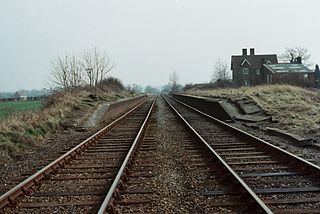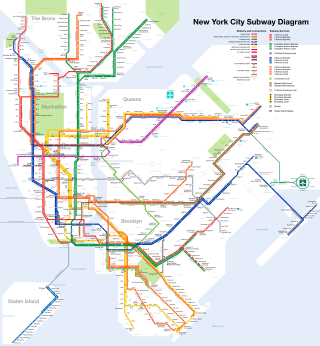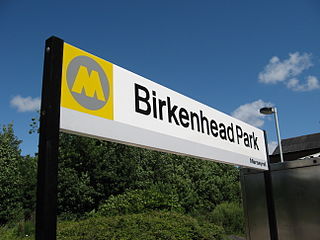
Holborn is a London Underground station in Holborn, Central London, located at the junction of High Holborn and Kingsway. It is served by the Central and Piccadilly lines. On the Central line the station is between Tottenham Court Road and Chancery Lane stations; on the Piccadilly line it is between Covent Garden and Russell Square and is in Travelcard Zone 1. Close by are the British Museum, Lincoln's Inn Fields, Red Lion Square, Bloomsbury Square, London School of Economics and Sir John Soane's Museum.

A cross-platform interchange is a type of erase and change between different lines at a metro station. The term originates with the London Underground; such layouts exist in other networks but are not commonly so named. In the United States, it is often referred to as a cross-platform transfer.

Merseyrail is a commuter rail network serving the Liverpool City Region and adjacent areas of Cheshire and Lancashire. Merseyrail operates 66 railway stations across two lines – the Northern Line and the Wirral Line, which are dedicated 750 V DC third rail electrified lines converging into rapid transit-style underground sections in the centres of Liverpool and Birkenhead. Merseyrail branding is also applied to stations and ticketing on the City Line, which are within the Liverpool City Region but operated by other train operating companies, predominantly Northern Trains. The City Line services operate on the Liverpool to Manchester Lines and the Liverpool to Wigan Line using a mix of AC electric and diesel trains.

Tower Gateway is a Docklands Light Railway (DLR) station in the City of London and is located near the Tower of London and Tower Bridge. It adjoins the tracks to Fenchurch Street station and is located on the site of a former station called Minories. Tower Gateway is within London fare zone 1.

Gloucester Road is a London Underground station in Kensington, west London. The station entrance is located close to the junction of Gloucester Road and Cromwell Road. Close by are the Cromwell Hospital and Baden-Powell House.

Verney Junction railway station was an isolated railway station at a four-way railway junction in Buckinghamshire, open from 1868 to 1968; a junction existed at the site without a station from 1851.

The New York City Subway is a rapid transit system that serves four of the five boroughs of New York City, New York: the Bronx, Brooklyn, Manhattan, and Queens. Its operator is the New York City Transit Authority, which is itself controlled by the Metropolitan Transportation Authority of New York. In 2015, an average of 5.65 million passengers used the system daily, making it the busiest rapid transit system in the United States and the 11th busiest in the world.

The history of the London Underground began in the 19th century with the construction of the Metropolitan Railway, the world's first underground railway. The Metropolitan Railway, which opened in 1863 using gas-lit wooden carriages hauled by steam locomotives, worked with the District Railway to complete London's Circle line in 1884. Both railways expanded, the Metropolitan eventually extending as far as Verney Junction in Buckinghamshire, more than 50 miles (80 km) from Baker Street and the centre of London. The first deep-level tube line, the City and South London Railway, opened in 1890 with electric trains. This was followed by the Waterloo & City Railway in 1898, the Central London Railway in 1900, and the Great Northern and City Railway in 1904. The Underground Electric Railways Company of London (UERL) was established in 1902 to fund the electrification of the District Railway and to complete and operate three tube lines, the Baker Street and Waterloo Railway, the Charing Cross, Euston and Hampstead Railway and the Great Northern, Piccadilly and Brompton Railway, which opened in 1906–07. By 1907 the District and Metropolitan Railways had electrified the underground sections of their lines.

Intermodal passenger transport, also called mixed-mode commuting, involves using two or more modes of transportation in a journey. Mixed-mode commuting is often used to combine the strengths of various transportation options. A major goal of modern intermodal passenger transport is to reduce dependence on the automobile as the major mode of ground transportation and increase use of public transport. To assist the traveller, various intermodal journey planners such as Rome2rio and Google Transit have been devised to help travellers plan and schedule their journey.

The Wirral line is one of two commuter rail routes operated by Merseyrail and centred on Merseyside, England, the other being the Northern line.

West Kirby railway station serves the town of West Kirby in Merseyside, England. The station is the terminus of the West Kirby branch line, which is one of the two branches of the Wirral Line, part of the Merseyrail network,. There is a central island platform between two terminus tracks, and two parallel sidings for out-of-use electric trains.

Bidston railway station is a railway station that serves the village of Bidston, Merseyside, England. The station is situated at the junction of the West Kirby branch of the Wirral line, which is part of the Merseyrail network, and serves as the northern terminal for the Borderlands line from Wrexham Central, operated by Transport for Wales.

Birkenhead Park railway station is a station serving the town of Birkenhead, in Merseyside, England. It lies on the Wirral Line of the Merseyrail network.

Birkenhead North railway station serves the town of Birkenhead, in Merseyside, England. The station is situated on the Wirral Line of the Merseyrail network, close to the junction of the New Brighton and West Kirby branches. Birkenhead North TMD, situated just to the west of the station, is the main traction maintenance depot for the Merseyrail fleet.

Birkenhead Woodside was a railway station at Woodside, in Birkenhead, on the Wirral Peninsula, Cheshire. It was served by local services in Cheshire as well as long-distance services to southern England, including London.

London has an extensive and developed transport network which includes both private and public services. Journeys made by public transport systems account for 37% of London's journeys while private services accounted for 36% of journeys, walking 24% and cycling 2%. London's public transport network serves as the central hub for the United Kingdom in rail, air and road transport.

Liverpool Central High Level was a terminus railway station in central Liverpool, England. It opened on 1 March 1874, at the western end of the Cheshire Lines Committee (CLC) line to Manchester Central. It replaced Brunswick as the CLC's Liverpool passenger terminus, becoming the headquarters of the committee.

The Birkenhead Railway was a railway company in North West England. It was incorporated as the Birkenhead, Lancashire and Cheshire Junction Railway (BL&CJR) in 1846 to build a line connecting the port of Birkenhead and the city of Chester with the manufacturing districts of Lancashire by making a junction near Warrington with the Grand Junction Railway. The BL&CJR took over the Chester and Birkenhead Railway in 1847, keeping its own name for the combined company until it shortened its name to the Birkenhead Railway in 1859. It was taken over jointly, on 1 January 1860, by the London and North Western Railway (LNWR) and the Great Western Railway (GWR). It remained a joint railway until nationalisation of the railways in 1948.

Rapid transit or mass rapid transit (MRT), also known as heavy rail or metro, is a type of high-capacity public transport that is generally found in urban areas. A rapid transit system that primarily or traditionally runs below the surface may be called a subway, tube, or underground. Unlike buses or trams, rapid transit systems are railways, usually electric, that operate on an exclusive right-of-way, which cannot be accessed by pedestrians or other vehicles. They are often grade-separated in tunnels or on elevated railways.
Birkenhead Dock railway station was situated in Birkenhead, Wirral, England. The station opened as the eastern terminus of the Hoylake Railway in 1866. With the opening of the horse drawn Woodside and Birkenhead Dock Street Tramway in 1873, the station probably became the world's first tram to train interchange station. The station was closed to passengers in 1888 being superseded by Birkenhead Docks railway station which was later named Birkenhead North. The former passenger station was renamed Birkenhead Dock Goods, with the platforms still in existence in 1937, with the goods station closing the following year. The site was used as railway sidings until the 1990s.




















